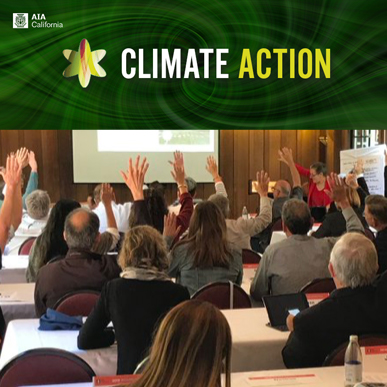
Friday, July 12, the AIA CA Board of Directors voted unanimously to support adoption of the Zero Code into the California Building Code. But first, a few words and background:
Sustainability. Resiliency. Climate Action. Urgent. Distribution grid. Move the needle. Centralized. Production. Improved Structural Performance. Green Concrete Selector. Game Changer. The question of landfill. Carbon Dioxide. Carbon Neutral. Embodied Carbon. Domestic water system.
When in a room with an intelligent, passionate group of architects waiting to hear, learn and offer what they can do next, there is no way the above list can be dismissed as a collection of “buzz” words. (For more on the above list, check out the AIA CA Climate Action Workshop Glossary. Architects made their plea, some with tears, some with raised voices, some quietly drawing on a napkin images of designs that embrace Zero Code, the national and international building energy standard for new building construction that integrates cost-effective energy standards with on-site and off-site renewable energy resulting in zero-net carbon buildings.
To help leaders understand the issues and implications of taking a proactive stand on this important issue, AIA California organized the Climate Action Workshop. This day-long session featured
Ed Mazria, FAIA, Charles Ely, FAIA, John Andary, Juliet Christian-Smith, PhD, Senior Program Officer for Water Foundation and Larry Strain, FAIA. All experts made a passionate plea for swift and bold action and then led a series of breakout conversations about implementation. California Energy Commissioner (CEC), Andrew McAllister, was on hand to give a state of the state report regarding California’s goals. Together, ideas and opportunities for how architects could be leaders in addressing this global issue. According to Mazria’s presentation, by 2060, the building floor area will double the current worldwide building stock. And 40 percent of this construction is expected to take place during the next 15 years. (Global Status Report, GABC.)
Lisa Mathissen, FAIA was an instrumental force in planning the workshop, and Liz Gibbons, AIA moderated and facilitated.
During a series of breakout sessions board members had focused and in-depth discussions in the subject areas of Water, Carbon, and Energy with incorporations firms can use to be proactive in climate action.
Subsequently, at the July 12 board meeting, the board voted unanimously to support adoption of the ZERO Code into the California Building Code as soon as possible. “The unanimous vote in support of the zero code adoption brought us all goosebumps in understanding the gravity of the decision and the optimism of potentially making a real difference regarding climate action,” said AIA CA President Benjamin Kasdan, AIA.

Show of hands. The @aiacalif supports adoption of the ZERO Code.
Now the real work begins and next steps are strategized. Advocacy and education are paramount at the helm of what the AIA CA as an association can do.
With those subjects in mind, AIA CA will take the first step in sending a letter strongly supporting that Zero Code be implemented into the California Building Code to Governor Newsom. There will also be follow-up with Commissioner McAllister to offer assistance to CEC. And there will be a significant shift in focusing efforts on outreach to other organizations to bring educational opportunities to our members. “We know there’s going to have to be a significant commitment to providing education and resources to the profession and we’ll work with tour members develop a plan for 2020,” said AIA CA Executive Vice President, Nicki Dennis Stephens, Hon. AIA CA.
There is much to be done, and time is of the essence. Stay tuned for future updates and calls to action as we move steadily onward.


